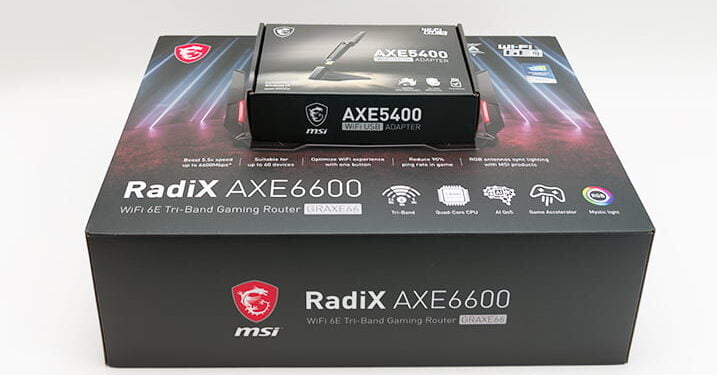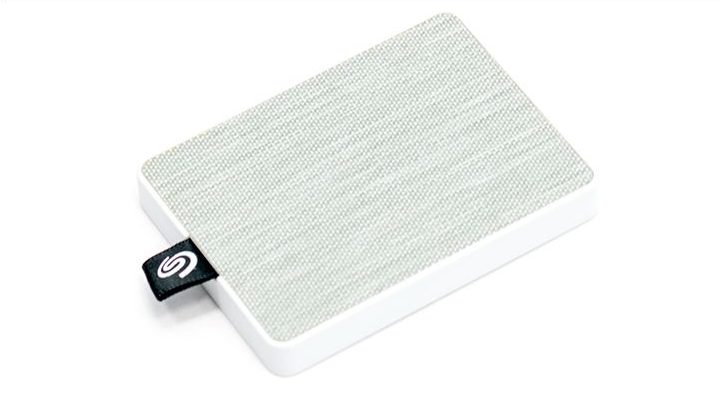In a perfect world every home would come with multiple 100G fiber optic ports per room. In a decent world every home would come with 10G Cat6A backed ports in every room. Sadly, we live in ClownWorld where most networking enthusiasts don’t even have a single 1GbE port in every room of their home. With the ever growing need for networking connectivity this has left the door wide open for wireless ‘WiFi’ solutions to solve this ongoing problem. While WiFi 7 standard has just been formalized WiFi 6E and its “6Ghz” band is about as fast a fully compliant solution as one can get. Sadly, while finding good 6E routers is not overly difficult finding good WiFi 6E adapters is anything but. This is where upstart (to this industry) MSI enters the chat with their one-two combination of 6E Router (the Radix AXE6600 at a reasonable online average of $250 USD) and the highly impressive USB AXE5400 (with a reasonable online average of only $60 USD).
So as not to get too lost in the weeds, for the purposes of this review we will be mainly focusing in on MSI’s new AXE5400 and just briefly (for us) going over the Radix AXE6600. We will be doing so because the AXE5400 is a rather interesting take on USB based WiFi adapter design. Typically, when enthusiasts or experts say the word ‘interesting’ what they really mean is its choke full of problems, or is more of an example of what not to do. For example, “that is a rather interesting network configuration you have there Bob” usually translates to “Did you design this network before or after your guest appearance at the local Uncle-Daddy & Aunty-Momma convention?”. This is not the case here. MSI’s AXE5400 promises to be the exception to the rule. Even just looking at the specifications shows it to be at least a decent example of this new breed of WiFi adapter and what they have to offer and it promises to be more than just ‘decent’. That is to say MSI has combined reasonably long external antennas, reasonable weight (a mere 46grams), reasonable size (for its class), with a reasonably good consumer grade controller (Realtek RTL8832CU). All of which should equate to a good USB based WiFi adapter.

In typical overachiever fashion MSI has then upped the ante by including three other features. Features which on their own are not unique, but rarely combined into one cohesive ‘user-friendly’ package. The first is an actually good, stable, and useable single port docking station for desktop use. Thanks to its integrated 1-meter length cable, this dock means that you not only can but actually want to use a rear I/O USB 3.0 (aka 3.2 gen 1 aaaka USB 5Gbps) port instead of the always in high demand front of your case USB ports. The next is this adapter is truly plug and play with the driver installation package coming baked right into a small onboard storage chip. Simply plug it in and it will start to install process for you. Yes. That means that even if your computer does not have a working NIC or WiFi adapter already installed you will be up and running in seconds with this bad boy… and not scrambling to get to a working computer to download said Realtek driver package(s).
The last is the price. While sixty US dollars may seem like a hefty chunk of cash for a USB based WiFi adapter… WiFi 6E is not cheap. In fact, many older WiFi 6 adapters demand what MSI is asking for their WiFi 6E model. For example, Asus and its old RTL8832AU based USB-AX56 is more at ~75 USD, and TP-LINK and their Archer TX20UH (RTL8832BU based) is about the same at $70. Compare and contrast that with the latest gen 32CU MSI is offering for a mere $60 and it is patently obvious that MSI intends to offer better performance, better ease of use, and do both while also offering a better value. Now that is how you make a splash into a market you have not really been seen in for a decade!











